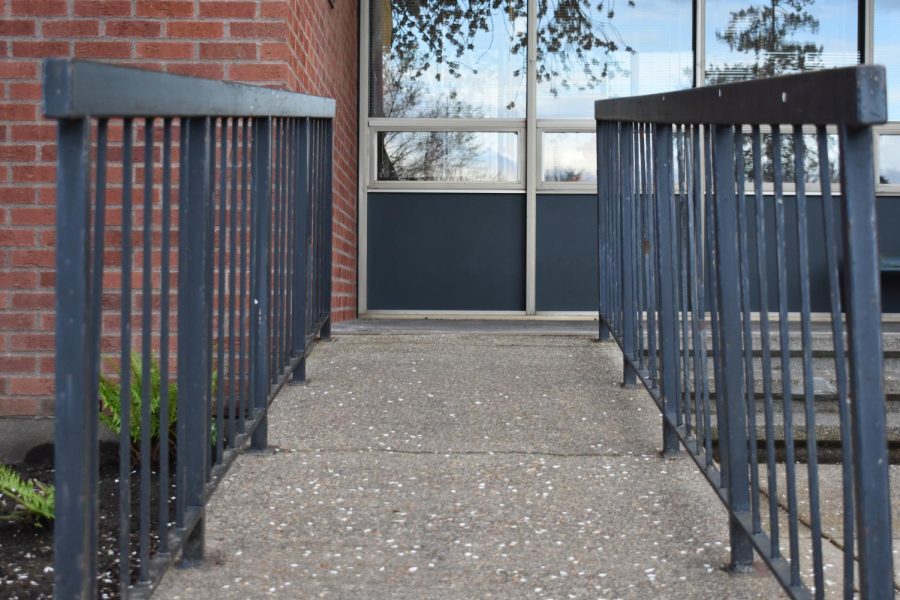Accessibility on campus has room for improvement, students say
April 18, 2022
In the fall of 2021, freshman Grace Fjermedal started the school year on wheels. Fjermedal has a neuroinflammatory autoimmune disease and nerve damage, which caused her to lose the use of her arm for months and the ability to walk for a year. After facing the hardships of a first semester of college on a knee scooter, she became very interested in making campus more accessible.
“I had a pretty terrible first week on campus,” said Fjermedal. “There were a lot of fun events planned and I wasn’t able to do them, because they were all on grass or involved physical activity. So I got interested in helping [the Residence Hall Association] make activities more accessible.”
Students are encouraged to use their voices to advocate for changes in Linfield University’s accessibility, both physically and academically. “Making campus more accessible based on [Americans with Disabilities Act] regulations, makes campus more inclusive and accessible for all,” said Jeff Larson, director of Learning Support Services (LSS) at Linfield University.
The Americans with Disabilities Act was passed by Congress in 1990. This act is a public access law that was created to prevent discrimation based on disability status. Any public facing program, such as schools, government, and public locations, must follow the regulations under this act to be accessible for all users.
After joining RHA, Fjermedal met other students who faced similar issues and experiences on campus. One of these students was fellow freshman Clara Johansen. Johansen has a genetic degenerative retinal condition which has rendered her legally blind her whole life. What most people see at 20 feet away, Johansen sees at 300.
This causes challenges for Johansen when it comes to tasks like using stairs. In accordance with ADA regulations, stairs are supposed to be marked with metal plates, paint, or divots along the edge. Many sets of stairs at Linfield do not follow this.
“Depending on the shadows and stuff outside I won’t be able to see where the edges of the stairs are,” said Johansen. “For someone like me, that’s really dangerous and I’ve actually tripped walking out of Pio.”
Fjermedal said other problems brought up at RHA included the broken automatic door in Mahaffey Hall and the lack of curb cuts in multiple locations across campus.
“When I was on wheels it was such a struggle. Sometimes I would just gun it and fly off of [the sidewalk], which isn’t the safest thing to do,” said Fjermedal. “My other option was to go all the way up the street, across the street, and all the way back down.”
Accessibility fixes, such as marked stairs and curb cuts, can help a wider population than just the disabled community on campus. Fjermedal said this is called the “curb cut effect.” Imagine move-in and move-out with more curb cuts or marked stairs to avoid tripping when walking to and from class. These little changes on campus can be beneficial to all students, faculty, and visitors–not just those with a disability.
The LSS office is a resource for helping students implement accessibility changes they wish to see on campus. Some requests are easier than others. For example, adding an elevator to a residence hall would take a lot more planning and funding than marking steps. The LSS office is also responsible for making physical accommodations for students by moving classrooms and creating housing accommodations.
Fjermedal said the LSS office is doing good work, but she knows there’s more that could be done.
Larson agrees. He said there are things Linfield does really well, but he “won’t be happy until it’s perfect.”
“No one meets the standards. Being fully transparent, there are always things that could be better, or could be improved upon. Especially when talking about physical access,” Larson said. “Colleges are usually places where buildings were built a long time ago. New buildings have requirements that make them fully accessible, old buildings don’t have a requirement unless being retrofitted.”
“It’s good, but there is a lot of room for improvement and I don’t think that is unique to Linfield,” Larson said. “There are a lot of pockets accessible, but to say we are 100% there is not accurate.”
Larson encourages students to use their voice to make change on campus. If a student sees a program, building, or class that is not fully accessible, these concerns need to be reported to LSS. Students can also reach out to specific departments, locations, or to campus facilities, depending on the nature of the issue.
“If there is something that is creating a barrier or is not fully accessible, make that known. Our office can be a place for that,” Larson said. “Whatever passion you have for a particular project or barrier to be addressed, gather some momentum around that. I think there is a desire to make things more accessible.”

